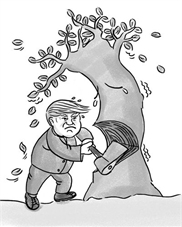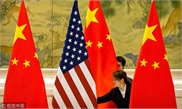https://youtu.be/82NLXvMtn64
 Chinese Vice Premier Liu He arrives at the the Office of the United States Trade Representative for negotiations on a trade deal
Chinese Vice Premier Liu He arrives at the the Office of the United States Trade Representative for negotiations on a trade dealThe United States pulled the trigger Friday on a steep increase in tariffs on Chinese products and Beijing immediately vowed to hit back, turning up the heat before a second day of trade negotiations.
President Donald Trump got a briefing from his trade negotiators after the first day of talks with the Chinese side on Thursday, but made no move to hold off on the tariffs -- dashing hopes there might be a last-minute reprieve as the negotiations continued.
Minutes after the US increased punitive duties on $200 billion in imports from 10 to 25 percent, the Chinese commerce ministry said it "deeply regrets" the move and repeated its pledge to take "necessary countermeasures", without elaborating.
Locked in a trade dispute for more than a year, officials from the world's two biggest economies returned to the bargaining table late Thursday, led by Chinese Vice Premier Liu He, US Trade Representative Robert Lighthizer and US Treasury Secretary Steven Mnuchin.
Since last year, the two sides have exchanged tariffs on more than $360 billion in two-way trade, gutting US agricultural exports to China and weighing on both countries' manufacturing sectors.
Trump began the standoff because of complaints about unfair Chinese trade practices.
The US team met with Trump late Thursday night to brief him and "agreed to continue discussions" on Friday, the White House said in a statement.

AFP / Jonathan WALTER US-China trade
Lighthizer and Mnuchin met the Chinese delegation for about 90 minutes Thursday evening and they had a working dinner with Liu.
"We hope the US and the Chinese side can meet each other halfway and work hard together to resolve existing problems through cooperation and consultation," the Chinese commerce ministry said in a statement.
Despite optimism from officials in recent weeks that the talks were moving towards a deal, tensions reignited this week after Trump angrily accused China of trying to backpedal on its commitments.
"They took many, many parts of that deal and they renegotiated. You can't do that," Trump said on Thursday.
But he held out hopes of salvaging a deal.
"It's possible to do it," Trump said. "I did get last night a very beautiful letter from President Xi (Jinping)."
At the same time, he said he would be happy to keep tariffs in place. And he has threatened to extend the tough duties to all Chinese goods.
Michael Taylor, a managing director for Moody's Investors Service, said the tariff hike "further raises tensions" between the two countries.
"While we believe that a trade deal will eventually be reached between the US and China, the risk of a complete breakdown in trade talks has certainly increased," Taylor said.
- Tariffs increase -
The renewed tensions roiled global stock markets this week and unnerved exporters, though Chinese shares led gains across most Asian and European markets on Friday.
 AFP / ANDREW CABALLERO-REYNOLDS US Trade Representative Robert Lighthizer (L) and Treasury Secretary Steven Mnuchin wait to greet Chinese Vice Premier Liu He for trade talks
AFP / ANDREW CABALLERO-REYNOLDS US Trade Representative Robert Lighthizer (L) and Treasury Secretary Steven Mnuchin wait to greet Chinese Vice Premier Liu He for trade talksLiu said on his arrival in Washington that the prospects for the talks were "promising," but warned that raising tariffs would be "harmful to both sides," and called instead for cooperation.
"I hope to engage in rational and candid exchanges with the US side," he told Chinese state media.
"Of course, China believes raising tariffs in the current situation is not a solution to the problem, but harmful to China, to the United States and to the whole world."
The higher duty rates will hit a vast array of Chinese-made electrical equipment, machinery, auto parts and furniture.
But due to a quirk in the implementation of the higher tariffs, products already on ships headed for US ports before midnight will only pay the 10 percent rate, US Customs and Border Protection explained.
That could effectively provide a grace period for the sides to avert serious escalation.
 AFP / Andrew Caballero-Reynolds An anti-China protester (C) yells at a pro-China demonstrator outside the Office of the United States Trade Representative as US and Chinese officials hold tariff negotiations in Washington
AFP / Andrew Caballero-Reynolds An anti-China protester (C) yells at a pro-China demonstrator outside the Office of the United States Trade Representative as US and Chinese officials hold tariff negotiations in Washington"While we are disappointed that the stakes have been raised, we nevertheless support the ongoing effort by both sides to reach agreement on a strong, enforceable deal that resolves the fundamental, structural issues our members have long faced in China," said business lobby the American Chamber of Commerce in China.
The US is pressing China to change its policies on protections for intellectual property, massive subsidies for state-owned firms, and reduce the yawning trade deficit.
Derek Scissors, a China expert at the American Enterprise Institute, said the two sides had clashed over how much of the final trade agreement should be enshrined in a public document, something Beijing has long resisted.
"What the Chinese step-back primarily says is they don't want to publicly acknowledge that their existing laws, especially on IP, are flawed," he told AFP.
Washington is counting on the strong US economy to be able to withstand the impact of higher costs from the import duties and retaliation better than China, which has seen its growth slow.
A Chinese central bank advisor told state-run Financial News that Trump's tariff hike and Chinese retaliation would lower economic growth by 0.3 percentage points.
It is "within a controllable range", the advisor Ma Jun saidA.
By AFP / ANDREW CABALLERO-REYNOLDS
Read more:
Trump orders tariff hike on remaining Chinese imports | Free Malaysia ...
China vows to counter US tariffs
Beijing has many ways to make Washington pay
Chinese
Vice Premier Liu He (left) shakes hands with US Trade Representative
Robert Lighthizer (center) alongside US Treasury Secretary Steven
Mnuchin as Liu arrives at the Office of the US Trade Representative for
trade negotiations in Washington DC, Friday. Photo: AP
After months of truce, the trade war between China and the US escalated on Friday, after the US shrugged off widespread warnings and moved to hike tariffs on Chinese goods, drawing a firm response from China, which vowed to retaliate.
Though Chinese and US officials are continuing talks, the renewed tensions between the world's two largest economies significantly complicated ongoing negotiations, dimmed the prospects of any potential trade agreement and stoked fear that a full-fledged trade war could still break out. And the US is to blame for the risky turn of events, Chinese officials and analysts stressed.
After days of repeated threats, US officials on Friday noon (Beijing Time) increased an existing 10 percent tariff on $200 billion in Chinese goods to 25 percent, breaking a truce reached by the leaders of the two countries in December 2018 and highlighting the unreliable and unpredictable nature of the US administration.
Minutes after the US tariff hike took effect, China struck back. In a statement, the Chinese Ministry of Commerce (MOFCOM) said that China "will have to take necessary countermeasures," while still urging the US to meet China halfway in ongoing negotiations in Washington.
Even as tensions escalated, officials pushed through with the 11th round of negotiations as they try to make a last-ditch effort to bring the months-long talks back on track for a trade agreement.
The Chinese delegation was seen arriving at the Office of the US Trade Representative at around 5 pm on Thursday US time and left about an hour and half later. The talks will continue on Friday morning, according to US media reports.
"We are now at a very delicate place, where further negotiations have become significantly more difficult… the risk of a further escalation also increased," Song Guoyou, director of Fudan University's Center for Economic Diplomacy, told the Global Times on Friday. "We cannot allow this to become normal. That would be dangerous."
Forced retaliation
Chinese officials have repeatedly stressed that China does not want to fight a trade war, but Washington's aggressiveness and belligerence left them no other option but to fight back, analysts said.
"China will also have to make good on its own words, otherwise, it will be at a huge disadvantage to the US team at the negotiations," said He Weiwen, a former senior Chinese trade official, told the Global Times on Friday, referring to China's earlier vow to retaliate if the US went ahead with the tariff threat.
Though the MOFCOM on Friday did not say what countermeasures China will take and when it will implement them, there are many ways China can inflict pain on the US economy, according to analysts.
"The most direct countermeasure would be raising existing tariffs on US goods or imposing tariffs on more US products," Song said. "However, we cannot rule out other policy tools."
Song pointed out that with the overall trade relationship souring, US companies' operations and investments in China could also be impacted, given the rising anger among the Chinese public toward the US.
In the wake of renewed tensions, calls on Chinese social media to boycott US products rose, including US films, iPhones and computers. "Why retaliate? All we need to do is boycotting US products," one internet user said on Sina Weibo.
Chinese analysts also suggested that China could target the US financial system, the backbone of the US economy, including unloading China's holdings of US Treasury bonds. Big US corporations and products, such as agricultural goods, will also likely encounter more scrutiny and resistance in China.
"Such an impact on US companies and industries will not be less severe than from the tariffs," Song said.
Many US business groups have expressed strong opposition to the tariffs. On Wall Street, US stocks have also suffered losses in the past few days, as have stocks in major bourses across the world.
Complicated outlook
While it remains to be seen whether trade officials could still make a breakthrough at the talks, it is clear that the escalation complicates the talks and dims prospects for a deal, analysts said.
"I don't expect too much from this round of talks," a source in Washington familiar with the talks told the Global Times on Friday, noting that US President Donald Trump had miscalculated.
"He initially wanted to show how he forced China into making concessions," the source, who spoke on condition of anonymity, said. "But that is like forcing China not to sign the deal quickly."
However, citing US eagerness, other observers have also argued that there is still a chance for the two sides to reach a deal.
"I think there is still a chance for the two countries to reach an agreement," Sang Baichuan, director of the Institute of International Business at the University of International Business and Economics in Beijing, told the Global Times on Friday, noting that the two sides still appear eager to reach a deal, despite their tough rhetoric.
In what appears to be an attempt to leave room for talks, US officials offered a grace period for the tariff hike. Trump also said on Thursday that a deal is still "possible" this week and that he might speak to Chinese President Xi Jinping by phone, CNBC reported.
Asked about the phone call, Geng Shuang, a spokesperson for the Chinese Foreign Ministry, said on Friday that he was not aware of such a plan but the two leaders have maintained close contact.
Read more:
US' maximum pressure policy is useless
China's stance is clear-cut. It is willing to reach a
deal but will never make concessions on issues of principle, nor trade
its core interests. In contrast, the US' attitude is swaying. Driven by
unrealistic anticipation, it has drifted between expressing optimism
that exceeds the actual situation and arbitrarily waving the tariff
stick. China has clarified its stance and will try to push the situation
in a good direction. If the US is to play a roller coaster-style
thriller game, it will bear the consequences.
Source: Global Times | 2019/5/12 22:47:27

Source: Global Times | 2019/5/12 21:50:35
 The US government escalated its trade war with China
significantly on Friday, raising tariffs on $200 billion worth of
Chinese goods. Beijing has vowed a tit-for-tat response meaning there is
an increasing probability that there will be a long and agonizing trade
dispute between the economic giants.
The US government escalated its trade war with China
significantly on Friday, raising tariffs on $200 billion worth of
Chinese goods. Beijing has vowed a tit-for-tat response meaning there is
an increasing probability that there will be a long and agonizing trade
dispute between the economic giants.
Source: Global Times | 2019/5/12 21:50:30
As a sign of positive developments in China-Vatican
relations, the recent Easter celebrations were peaceful in China and the
presence of the Vatican representation at the Horticultural
International Exhibition in Beijing attracted positive attention.
Cardinal Pietro Parolin(Parolin), Vatican Secretary of State, granted an
exclusive interview to the Global Times (GT) special correspondent
Francesco Sisci and staff reporter Zhang Yu. He talked about the latest
progress of the provisional agreement between China and the Holy See,
his memories of negotiating with Chinese representatives, and his take
on China's sinicization of religions in recent years.
Source: Global Times | 2019/5/12 22:47:27

Trump can't reverse US trade gap with tweets alone
In a tweet, US President Donald Trump said "Such an easy way to avoid Tariffs? Make or produce your goods and products in the good old USA. It's very simple!"Source: Global Times | 2019/5/12 21:50:35
Escalating tariff war with China, White House risks digging a hole for Americans
 The US government escalated its trade war with China
significantly on Friday, raising tariffs on $200 billion worth of
Chinese goods. Beijing has vowed a tit-for-tat response meaning there is
an increasing probability that there will be a long and agonizing trade
dispute between the economic giants.
The US government escalated its trade war with China
significantly on Friday, raising tariffs on $200 billion worth of
Chinese goods. Beijing has vowed a tit-for-tat response meaning there is
an increasing probability that there will be a long and agonizing trade
dispute between the economic giants.Source: Global Times | 2019/5/12 21:50:30
 Pope Francis sees China as great country, says cardinal
Pope Francis sees China as great country, says cardinal
As a sign of positive developments in China-Vatican
relations, the recent Easter celebrations were peaceful in China and the
presence of the Vatican representation at the Horticultural
International Exhibition in Beijing attracted positive attention.
Cardinal Pietro Parolin(Parolin), Vatican Secretary of State, granted an
exclusive interview to the Global Times (GT) special correspondent
Francesco Sisci and staff reporter Zhang Yu. He talked about the latest
progress of the provisional agreement between China and the Holy See,
his memories of negotiating with Chinese representatives, and his take
on China's sinicization of religions in recent years.
Related posts:
China won’t flinch in face of tough-talking US
Dialogue of civilizations can iron out cultural creases

















